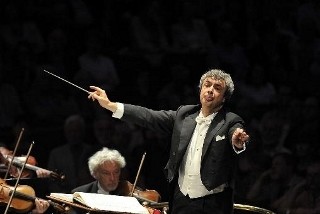|
Back
Climbing the Mountain New York
David Geffen Hall, Lincoln Center
05/24/2018 - & May 25*, 26, 2018
Luciano Berio: Sinfonia
Richard Strauss: An Alpine Symphony, opus 64
Roomful of Teeth
New York Philharmonic, Semyon Bychkov (conductor)

S. Bychkov (© Chris Christodoulou)
“...you wait for the compulsory show to begin, it takes time, you hear a voice, perhaps it is a recitation, that is the show, someone reciting, selected passages, old favorites, or someone improvising, you can barely hear him, that’s the show, you can’t leave, you are afraid to leave, you make the best of it, you try to be reasonable, you came too early, here we’d need Latin, it’s only the beginning, it hasn’t begun, he’ll appear any moment, he’ll begin any moment...”
Luciano Berio, Sinfonia
I started my career as a percussionist and it may be that I learned to love the Alpine Symphony because I hoped someday to operate the wind machine (I never did). Anyway I grew at sixes and sevens with Strauss, loving his early operas but not much interested in his later works for the theater, partly because they seemed too mannered for my taste and partly because he became in later life the president of the Reichsmusikkammer under the Nazi regime. To quote Alma Mahler “He had become an unashamed materialist, weighing his own advantage at every turn, a gambler on the stock exchange and an exploiter of the Opera.” However some of his works are monumentally evocative and this essay is the standout of the lot. It is difficult to conjure a more exceptionally descriptive landscape from any of the great composers, even the tone poets like Liszt or Berlioz.
Luciano Berio sometimes composed in the same monumental style and his Sinfonia is a gigantic work. Well over 100 musicians were on the David Geffen stage but not one of them was the concertmaster Frank Huang. Rather Principal Associate Concertmaster Sheryl Staples was in the chair and this delighted this reviewer as I have heard enough to judge the overall sound of the ensemble more zaftig, more lovely, more organic and more dynamic with Ms. Staples in the first position. The Berio essay is interesting but strictly dated as a relic of the late ‘60’s. In the very first movement there were walkouts by audience members and one brave soul applauded after this opening section.
Sinfonia has a little bit of everything. Movement two includes religious, angelic voices (the Roomful of Teeth) and the entire movement becomes an ascension. After this relatively standard device the work veers off into the abyss of late ‘60’s rock and roll psychedelics, wallowing in cliché, Sprechstimme effects and many quotes from Mahler’s “Resurrection”. There was far too much speaking by the vocalists and many bromides now recognized as “Easy Rider” effects. However, the performance, judged on its own merits, was excellent. The score of this pastiche is undoubtedly on a dusty shelf at the Library of Congress, where it should stay forever.
With the huge Berio on the program, it was surprising to see at least as many people on the stage after intermission, but Strauss fashioned a Leviathan for arguably his greatest orchestral achievement. There were so many musicians that they left little room for movement. However, Maestro Bychkov, shirtsleeves exposed, kept them all in check while eliciting some of the most romantic and supple phrasings in years at the Philharmonic. The piece begins with a horn, an instrument that will dominate this rarefied atmosphere. Strauss’s father was the great hornist Franz Strauss, so the Alpine relationship with the instrument permeates this orchestral essay. The Philharmonic horns as a whole, who sometime run off the rails, were on their best behavior this day.
With the celli front stage left, the lower line was powerful throughout. There were so many moving parts that it was a wonder that this visiting conductor kept them all on track. For an organist they employed a local New York legend, Kent Tritle, while the percussion section was truly stunning, the wind machine operator extremely invested and, oh yeah, there was a gigantic thunder sheet hanging from the rafters. With a wonderful ending straight out of the Opernhaus, this performance was the best of any essay that I have heard from the Phil in several years. Kudos!
When I was a young drummer I helped to found the Brahms-Schoenberg Club, a group that met to study the genesis of current trends in serious art music. This was the early 1960’s and some on that cutting edge were what I labelled the “Second Venetian School”, whose members included composers Luigi Nono (married to Schoenberg’s daughter Nuria), Bruno Maderna and Luciano Berio (married to contemporary singer Cathy Berberian). Performers Claudio Abbado, Giuseppe Sinopoli and Maurizio Pollini were also part of the group. Aside from Ms. Schoenberg, only Pollini is still with us and shows little sign of slowing down. I on the other hand...
Fred Kirshnit
|